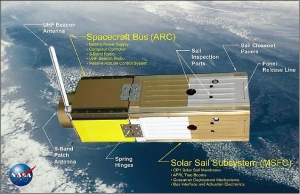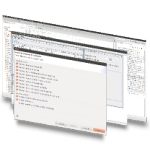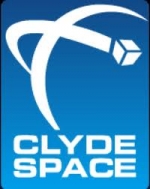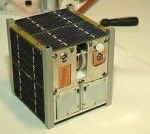Displaying items by tag: nano satellite
AAC Clyde Space
At AAC Clyde Space we specialise in providing advanced small spacecraft, mission services, and subsystems. We are the market leader in small satellite solutions and services for government, commercial, and educational organisations.
NanoSail-D2
NanoSail-D2 is a technology demonstration experiment of NASA with the primary objective to deploy a compact solar sail boom system in space.
In a previous attempt, a team from the NASA/MSFC, along with a team from the NASA/ARC (Ames Research Center), developed a solar sail mission called NanoSail-D which was lost in a launch failure aboard a Falcon 1 rocket on August 3, 2008.
Two units of the NanoSail-D satellites have been built. NASA/MSFC plans to launch the backup NanoSail-D payload from a 3U CubeSat (nanosatellite) of ARC on the FASTSat-HSV mission. FASTSat is required to launch the nanosatellite before the NanoSail-D2 payload can be launched and deployed from the nanosatellite.
Generation 1 Onboard Software
Bright Ascension’s Generation 1 Onboard Software product, or Gen1 for short, combines our mature component-based software framework with proven software components and an Eclipse-based tool system.
It provides an excellent solution for the command and data handling needs of the next generation of highly-capable CubeSats and other nano-satellites. Gen1 will enable you to rapidly and cheaply produce robust software for your spacecraft whatever subsystems you choose, and, where we already provide support for your subsystems, get a near-complete solution out-of-the-box. Bright Ascension are also able to offer bespoke solutions based on this software, letting you focus on the aspects of the mission that are most important to you.
Key Benefits
Rapidity
Rather than writing software from scratch, Generation 1 provides you with most of the functionality you need off-the-shelf. This allows you to focus on producing or procuring code to cover the unique parts of your mission. Whatever development you do, cross-platform support means most development and testing can be done on desktop PCs without access to flight hardware or engineering models. On the ground side, we include a graphical test application software which will provide telemetry monitoring and telecommand to support your development and AIT activities.
Flexibility
The component-based architecture we’ve used for Generation 1 means that software can be assembled from a library of existing, validated code and supplemented with new components to introduce new capabilities.
This flexibility extends into orbit, with a high level of reconfigurability and automation to cope with evolving mission needs and provide plenty of troubleshooting options.
Portability
Generation 1 was designed with portability in mind. An abstraction and layer and flexible build system make it straightforward to add support for new operating systems and architectures. It is also easy to develop your onboard software on one platform, such as desktop PC, and transfer your working solution to another platform, such as an onboard computer, with few, if any, changes.
Interoperability
Wherever possible we adopt recognised and mature international standards to promote interoperability and portability. Generation 1 uses CCSDS standards for communications and for I/O handling on board giving you the most options for the operation of your spacecraft and adaptation of existing software to the Generation 1 framework. Gen 1 includes an ECSS Packet Utilisation Standard (PUS) compliant protocol stack, providing a standard TM/TC solution already compatible with many existing ground segments.
Robustness
Our heavily tested, proven code is developed to MISRA-C standards for safe, reliable embedded systems. Our scheduling system facilitates the development of robust, verifiable task schedules allowing you to be sure your onboard software will meet strict real-time requirements.
Ease of Use
We recognise the importance of good documentation which is why you will find comprehensive API reference documentation, a full user manual and thoroughly documented source code.
Bright Ascension Ltd
We started Bright Ascension in 2011 to offer a fresh and innovative approach to engineering research and development in the space industry and other high technology areas. We have a unique mix of down-to-earth, hard-nosed, practical engineering experience and a rigorous approach sharpened through academic research. Our varied back-catalogue means that we are as comfortable with abstract theoretical concepts as we are with getting our hands dirty and producing effective products in difficult conditions. Knowing the theory allows us to take a step back and offer a clear perspective on your problems; being practical means that we never lose sight of the real-world constraints you are working with.
We have applied our experience and innovation to Generation 1, our industry-leading onboard software product for Nano-Satellites, including CubeSats. Rather than being a one-size-fits-all solution, or requiring significant accompanying consultancy, Generation 1 is a software toolkit, allowing you to quickly and easily assemble onboard software to meet the needs of your mission from a library of proven software components, utilising our mature software framework and development tools. We can provide an end-to-end solution with the addition of our Generation 1 Mission Control System, which complements our onboard software to provide a complete solution from early prototyping, through early integration, AIT and on-orbit operations.
Clyde Space
Clyde Space is a supplier of small and micro spacecraft systems.
Clyde Space is specialised in high performance power subsystems, DC-DC Converters, lithium polymer batteries and high efficiency solar panels, typically for small satellite missions, and Attitude Control and Determination Systems.
Clyde Space is a CubeSat vendor, pioneered the CubeSat Shop, and is developing an advanced nanosatellite platform, aiming to be Scotland's first satellite, in conjunction with leading academic and commercial organisations.
CubeSat
A CubeSat is a type of miniaturized satellite for space research that usually has a volume of exactly one liter (10 cm cube), has a mass of no more than 1.33 kilograms, and typically uses commercial off-the-shelf electronics components. Beginning in 1999, California Polytechnic State University (Cal Poly) and Stanford University developed the CubeSat specifications to help universities worldwide to perform space science and exploration.
The majority of development comes from academia, but several companies have built CubeSats, including large-satellite-maker Boeing. The CubeSat format is also popular with amateur radio satellite builders.






